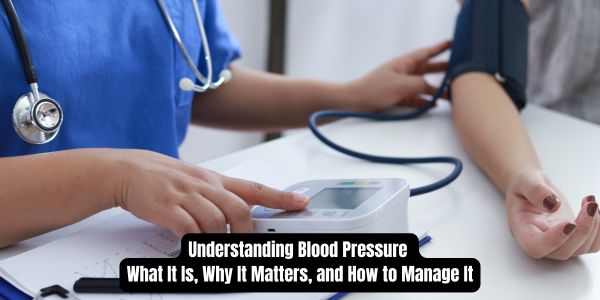Blood pressure (BP) is a term we often hear in doctor’s offices, fitness discussions, or health campaigns, but what does it really mean? Why does it matter so much? For millions worldwide, blood pressure problems—whether too high (hypertension) or too low (hypotension)—are a silent force impacting daily life, longevity, and overall well-being. In this explainer, we’ll dive deep into what blood pressure is, how it works, the issues that arise when it’s out of balance, the latest research, and practical precautions you can take to keep it in check.
What Is Blood Pressure?
Blood pressure is the force exerted by your blood against the walls of your arteries as your heart pumps it around your body. It’s measured in millimeters of mercury (mmHg) and recorded as two numbers: systolic pressure (the higher number, when the heart beats) over diastolic pressure (the lower number, when the heart rests between beats). For example, a reading of 120/80 mmHg is considered normal for most adults.
- Systolic BP: Measures the pressure during a heartbeat.
- Diastolic BP: Measures the pressure when the heart is at rest.
Think of it like water flowing through a hose: too much pressure can strain the hose (arteries), while too little might not deliver enough water (blood) to where it’s needed.
MUST READ: Explainer: Professional Doctorates – Bridging Expertise and Practice
The Scale of the Problem
Blood pressure issues are a global health concern. According to the World Health Organization (WHO), an estimated 1.28 billion adults aged 30-79 have hypertension, with nearly half unaware of their condition. Meanwhile, hypotension, though less common, can also cause debilitating symptoms like dizziness and fainting. In the United States alone, the Centers for Disease Control and Prevention (CDC) reports that nearly 1 in 2 adults has high blood pressure, contributing to over 500,000 deaths annually due to related complications like heart attacks and strokes.
High Blood Pressure (Hypertension): The Silent Killer
Hypertension occurs when BP consistently exceeds 130/80 mmHg (per the American Heart Association’s updated guidelines). It’s dubbed the “silent killer” because it often has no symptoms until it causes severe damage.
- Causes: Genetics, poor diet (high salt, low potassium), lack of exercise, stress, smoking, excessive alcohol, and underlying conditions like kidney disease or sleep apnea.
- Risks: Heart disease, stroke, kidney failure, vision loss, and aneurysms.
- Facts: The WHO notes that hypertension is a leading cause of premature death worldwide, yet it’s preventable and manageable.
MUST READ: Poverty: A Persistent Challenge to Sustainable Development
Low Blood Pressure (Hypotension): The Underestimated Threat
Hypotension is typically defined as BP below 90/60 mmHg. While it’s less talked about, it can be just as disruptive.
- Causes: Dehydration, blood loss, heart problems, endocrine disorders, or even standing up too quickly (orthostatic hypotension).
- Symptoms: Dizziness, fainting, fatigue, and in severe cases, shock.
- Facts: Though often benign, chronic low BP can signal underlying issues, especially in older adults.
Latest Research: What’s New in BP Science?
Science is constantly evolving to tackle BP problems. Here’s what’s making waves in 2025:
- Personalized BP Targets: A 2024 study in The Lancet suggests that BP targets should vary by age and health status, challenging the one-size-fits-all approach. For instance, older adults might benefit from slightly higher BP to maintain brain blood flow.
- Wearable Tech: Devices like smartwatches now offer continuous BP monitoring with greater accuracy, thanks to AI-driven algorithms. A 2025 report from the Journal of the American College of Cardiology highlights their potential to catch early warning signs.
- Gut Health Connection: Emerging research links gut microbiome imbalances to hypertension. A study from the University of California (published March 2025) found that probiotics might lower BP in some patients by reducing inflammation.
- New Medications: Drugs like angiotensin receptor-neprilysin inhibitors (ARNIs) are gaining traction for resistant hypertension, offering hope where traditional treatments fail.
- Lifestyle Over Pills: A landmark trial from the European Society of Cardiology (2024) reinforced that diet and exercise can reduce BP as effectively as some medications, with fewer side effects.
Who’s at Risk?
Certain groups face higher odds of BP problems:
- Age: Risk of hypertension rises after 40; hypotension is more common in the elderly.
- Genetics: Family history plays a big role.
- Lifestyle: Sedentary habits, obesity, and stress amplify risks.
- Gender: Men are more prone to hypertension before 50; women catch up post-menopause.
Precautions: How to Manage Your BP
The good news? You have more control over your blood pressure than you might think. Here’s how to keep it balanced:
- Monitor Regularly: Home BP monitors are affordable and easy to use. Aim for at least weekly checks if you’re at risk.
- Eat Smart: Follow the DASH diet (Dietary Approaches to Stop Hypertension)—rich in fruits, vegetables, whole grains, and lean proteins. Cut back on salt (under 2,300 mg daily) and processed foods.
- Move More: The CDC recommends 150 minutes of moderate exercise weekly, like brisk walking or cycling, to lower BP naturally.
- Manage Stress: Meditation, yoga, or even a daily 10-minute breathing exercise can reduce stress-induced BP spikes.
- Limit Vices: Cap alcohol at one drink per day for women and two for men. Quit smoking—it damages arteries over time.
- Stay Hydrated: For hypotension, increase water and salt intake (with a doctor’s guidance) to boost blood volume.
- See Your Doctor: If readings consistently stray from normal, don’t wait—consult a healthcare provider for tailored advice or medication.
The Bottom Line
Blood pressure problems don’t discriminate—they can affect anyone, often without warning. Yet, with awareness, modern tools, and simple lifestyle tweaks, we can turn the tide. As research advances, from gut health breakthroughs to wearable tech, the future of BP management looks promising. For now, take charge: know your numbers, understand your risks, and act today for a healthier tomorrow.

